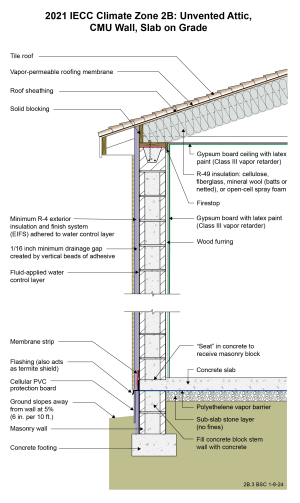Notes
Drawing 2B.3: IECC Climate Zone 2B: Unvented Attic, CMU Wall, Slab on Grade
- The attic insulation in this unvented attic is located on the underside of the roof sheathing. With tile roofing and vapor-permeable roofing paper, no venting or vapor diffusion ports are required for this roof assembly. If the roofing material were shingles, vapor diffusion ports would be needed. Unvented attics are more resistant to entry of embers from wildfires.
- If a raised-heel roof truss is used to allow R-38 attic insulation over the full width of the exterior wall, then R-38 can be used throughout the attic rather than R-49. See Section R402.2.1 of the 2021 IECC.
- The CMU block wall is insulated on the exterior with an exterior insulation and finish system (EIFS) adhered to a water control layer. Drainage occurs between the rigid insulation and the water control layer by the gap created by installing the EIFS with vertical beads of adhesive. The gap must be 1/16” minimum. The assembly is drained at the base of the wall with flashing. The EIFS insulation layer can be expanded polystyrene (EPS) or extruded polystyrene (XPS).
- A class III vapor retarder (latex paint) is used on the interior surface of the walls and ceiling instead of a vapor barrier. This allows drying to the interior. Avoid vinyl wallpaper and oil-based paint or coatings in Climate Zone 2. These wall coverings are vapor impermeable and increase the risk of condensation within the wall.
- The polyethylene vapor barrier under the concrete slab extends over the top of the CMU stem wall to act as a capillary break.
- The rigid insulation on the exterior of the slab-on-grade foundation is not a code requirement in Climate Zone 2 – it is recommended for comfort reasons. The flashing at the base of the above-grade wall is sealed to the water control layer with a membrane strip to control insect entry. EIFS laminas should not extend below grade – a cellular PVC protection board is recommended to protect the rigid insulation at grade.
- Portions of the CMU wall may need to be filled solid to meet structural requirements or to accommodate anchor bolts for a sill plate.
